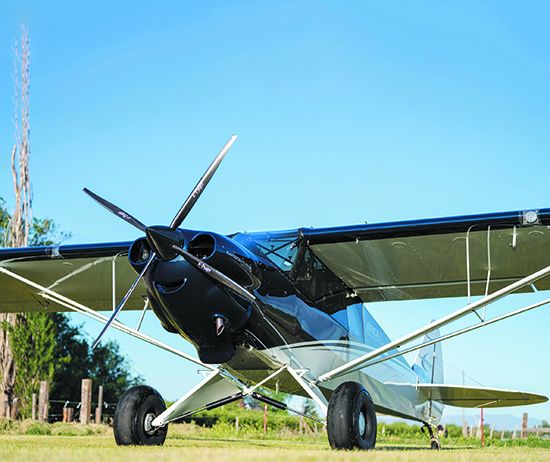
Airplanes anyone would recognize as a “Cub” are not always at the forefront of technology. The tube-and-fabric taildraggers seem to be glancing over their shoulders more often than looking ahead.
CubCrafters, the Yakima, Washington, manufacturer that now employs more than 220 people and kicks out Part 23-certified aircraft, LSA models and experimental kits while supporting a highly integrated builder-assist program, has other thoughts.
From its extensive use of carbon fiber and other lightweight materials inside a familiar Cub silhouette to having the temerity to put a nosewheel on a bush airplane, CubCrafters is unafraid to push the boundaries. This is another: the Carbon Cub UL, which is the company’s first use of any kind of Rotax engine and, it turns out, the first application of the new Rotax 916 powerplant. It’s based on the lightest configuration of the Carbon Cub SS LSA-compliant bushplane.
WHY THE ROTAX?
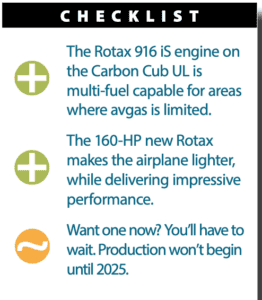
In describing the impetus behind the UL, CubCrafters’ Brad Damm said, “We needed an airplane for international markets. You have to have an airplane that runs on autogas. Avgas is available here but in some places in the world it simply isn’t. We also wanted an airplane that fit into the UL category around the world.” While the U.S. has LSA, other aviation authorities have different requirements for “lightweight” aircraft.
What is broadly referred to as the UL (or ultralight) category is not the same as our version. Most countries stick to the 600-kilogram weight limit (essentially the same as our 1320-pound limit for LSAs on wheels), though there are exceptions that go as high as 700 kg (1543 pounds). It’s true that other CubCrafters models fit into the LSA weight limits but what makes the UL compelling for the company is the multi-fuel (avgas and 94-octane autogas) capability of the Rotax.
Fitting the 916 to the UL is a natural from the weight standpoint. With the engine weighing just around 200 pounds, it goes a long way to keeping the overall weight down. Depending on props, the Rotax would be 40-70 pounds lighter than with the CC340 engine. The cowling is 30 percent lighter and the landing gear is titanium, as is the firewall. Up front, the E-Props four-blade prop weighs less than 9 pounds including hub and spinner.
“Our goal is to have the UL, at 1320 pounds maximum gross weight, have enough useful load for a 200-pound pilot, 120-pound passenger, 20 gallons of fuel and 20 pounds of baggage,” says Damm. If you’ve done the math, that’s an empty weight of 860 pounds, which is 32 pounds lighter than the listed spec for the Carbon Cub SS. “We’ve also fitted lighter avionics,” says Damm. “And we think there are other ways we can further reduce the empty weight.” Standard tankage is 25 gallons (24 usable).
THE ENGINE INSTALLATION
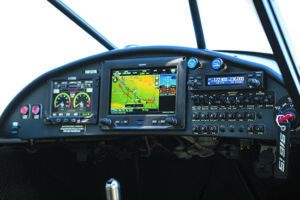
The 916 is a remarkably good fit on the front of the UL. It uses a conventional ring-style Rotax engine mount with extensions that pick up the firewall points common to the other engines used in the Carbon Cub SS series. Aside from the upper cowling using prepreg glass for weight reduction, the cowling overall is close to SS spec. The air inlets are rearranged, though. Under the spinner, the opening that normally feeds the airbox or carburetor ducts air to the oil cooler. In the copilot-side cheek, a splitter pulls incoming air back and toward the standard intercooler. Air entering the other side of the split and the pilot-side opening are led back to a pair of coolant radiators. A duct integrated with the top of the cowling helps feed a tall radiator just behind the engine while another is positioned along the lower surface of the cowling in the exit-air path.
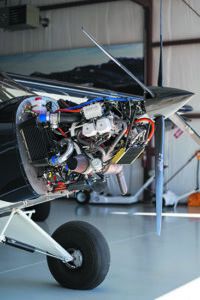
This arrangement is very likely to change. My flight in the airplane, on a not particularly warm day, began to stress the coolant temperatures, something CubCrafters has seen in its testing and is working to remedy as testing continues. They haven’t said what the exact next steps will be, but a betting person would plunk down on improving the cooling airflow before trying bigger, heavier radiators. It’s possible a general reshuffling of the back end of the engine might allow one larger radiator, but that’s a project for the near future.
The rest of the packaging is very tidy. Rotax supplies the turbocharger and exhaust system, which includes an electronically controlled wastegate. In the UL, induction air comes in via a large conical filter at the turbo inlet. Its location inside the cowling should stave off concerns of induction icing. As with all 900-series engines, there’s a remote oil tank on the pilot’s side of the firewall, meaning you get the joy of “burping” the system before flight to accurately check the oil level. On the firewall is the Rotax-supplied power-distribution system that manages the dual ECUs that, in turn, control fuel injection, ignition and wastegate functions. As with the 915, the 916 has a motorcycle-style generator on the back end of the crankshaft, though it has independent circuits. From certain angles, the installation looks really complex and fairly tight, but the important maintenance items are readily accessible. You drain oil from the remote tank and the oil filter lives on the front of the engine near the prop drive. All eight auto-style spark plugs are easily accessible, too.
FLYING IT
Pilots familiar with the Rotax 900-series engine and, in particular, the turbocharged 915 or non-turbo 912 iS will be immediately comfortable in the Carbon Cub UL. All the preflight actions are the same and allow both a single-lever power control and amazing efficiencies. On the runway, the Carbon Cub accelerates to flying speed with the customary one notch of flaps in less than four seconds and just seems to levitate. Once rotated and if you have no need to clear terrain, you can let the nose settle not far above the horizon and enjoy the view of the runway falling away from you.
In deference to the early stage of the UL’s cooling system, we pulled back to 95 percent throttle and dropped the nose to attain 78 knots indicated (90 MPH) and 500 FPM in the climb, where the coolant stabilized at 231 degrees F and the oil temp at 190 degrees. At this setting, the engine is pulling 37 inches of manifold pressure at 4800 engine RPM.
Later in the flight, we tested a full-power Vy climb (61 KIAS, 70 MPH) where we recorded 1100 FPM. Fuel flow is 10.3 GPH at 100 pervent throttle. At Vx, the airplane is substantially nose up to 46 KIAS (53 MPH) and still climbing better than 800 FPM. And let’s not forget that the turbocharged 916 can maintain full power (160 HP) to 15,000 feet and maximum continuous (137 HP) to 23,000 feet, which benefits high density-altitude takeoffs tremendously.
We followed that with a quick high-speed cruise check. At 98 percent throttle, the 916 is happily churning away at 42 inches and 5400 RPM, burning 9.9 GPH. At 4900 feet MSL, we saw 115 KTAS (132 MPH true). A more realistic cruise speed would be 95 percent throttle and 6.4 GPH, giving 104 KTAS (120 MPH true). Even more economical are the results at 94 percent throttle, where the UL trots along at 89 KTAS (102 MPH true) on 4.9 GPH; to get that, the Rotax is pulling 32 inches at 4700 RPM. Notable in this case is the engine’s smoothness and complete predictability with power changes. It moves from one thrust level to the next with complete seamlessness.
After a few minutes following rivers and observing wild horses from low level, Brad and I went to a local farmer’s field, conveniently located on a good-sized hill, for takeoffs and landings. The CarbonCub UL managed my ham-footedness with some forgiveness. Because it’s light and still has a ton of wing—179 square feet of modified USA 35(B) airfoil for just 1320 pounds—the UL loves to fly slowly and will come off the ground really quickly. In the landings where I was working hard to judge the sink rate as the steeply sloped runway came at me, I never thought about the engine or the drag profile. There’s always enough power and always enough control authority to get the job done.
And I never thought about the engine out front—what I asked for, it did. My single handling complaint is that I miss the lighter G-series flight controls on the larger models—the UL keeps the SS’s system because it’s lighter.
EARLY STAGES
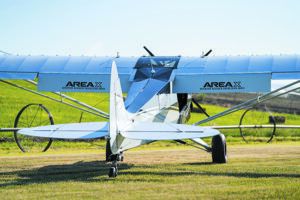
CubCrafters knows the UL has worldwide potential. Since starting the program with Rotax two years ago, it launched the airplane this spring at Sun ‘n Fun and will continue development on the engineering prototype I flew.
Early in 2024, the company expects to have half a dozen built for market survey purposes. That’s not likely to be the final design, either.
“We like to get customers into the airplane, to see what they like and don’t like,” says Brad Damm, “And then we can iterate the design from there.” The design gets locked in mid-2024, with the manufacturing team refining its part of the process through the end of the year. Prices have not been set but will probably be closer to the $312,000 of the EX-3/FX-3 series than the current $237,000 of the Carbon Cub SS.
Contributor Marc Cook is the Editor-in-Chief of sister publication KITPLANES Magazine.

